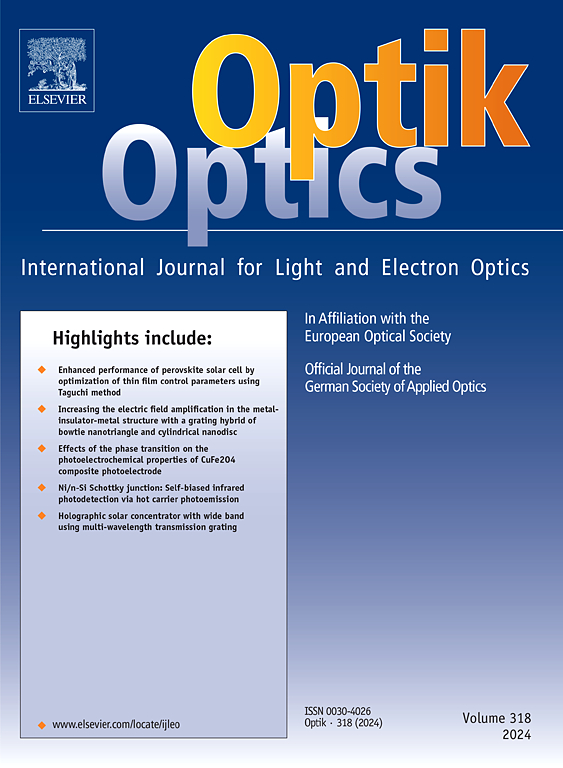利用AgSb2(SxSe1−x)3吸收剂设计增强型双端串联光伏器件
IF 3.1
3区 物理与天体物理
Q2 Engineering
引用次数: 0
摘要
最近,将银(Ag)集成到硫化锑硒化Sb(SxSe1−x)3薄膜中,突显了它们作为薄膜太阳能电池中高效吸光层的潜力。在这项工作中,我们设计并分析了AgSb(SxSe1−x)3和Sb2S3的双端单片串联太阳能电池。该新型串联器件配置了具有不同带隙的Sb2Se3光伏器件的AgSb(SxSe1−x)3底部亚电池和具有不同带隙Sb2Se3光伏器件的顶部亚电池,从而能够选择性地吸收目标光子能量。根据AgSb(SxSe1−x)3层在x硫磺= 0.2时优化的硫浓度,仔细校准上层吸收层的厚度,以提高性能。AgSb(S0.2Se0.8)3底部和Sb2Se3顶部亚电池的带隙能量分别为1.19 eV和1.7 eV。采用频谱滤波和电流匹配方法后,串联器件的开路电压(Voc)为1.63 V,短路电流密度(Jsc)为17.04 mA/cm2,填充因子(FF)为62.94 %。这些串联装置可能是未来光伏装置的有希望的候选者。功率转换效率为17.48 %,是高性能串联太阳能电池的理想选择。本文章由计算机程序翻译,如有差异,请以英文原文为准。
Designing enhanced two-terminal tandem photovoltaic devices with AgSb2(SxSe1−x)3 absorbers
Integrating silver (Ag) into antimony sulfide selenide Sb(SxSe1−x)3 thin films has recently highlighted their potential as efficient light-absorbing layers in thin-film solar cells. In this work, we have designed and analyzed two-terminal monolithic tandem solar cells with AgSb(SxSe1−x)3 and Sb2S3. The novel tandem device is configured with a AgSb(SxSe1−x)3 bottom subcell with and a top subcell with a Sb2Se3 photovoltaic device with different bandgaps, enabling the selective absorption of targeted photon energy. The upper absorber layer's thickness is carefully calibrated according to the sulfur concentration optimized at xsulfur = 0.2 of the AgSb(SxSe1−x)3 layer to enhance the performance. The bandgap energies for the AgSb(S0.2Se0.8)3 bottom and the Sb2Se3 top subcells are optimized at 1.19 eV and 1.7 eV, respectively. After employing spectral filtering and current matching methodologies, tandem devices demonstrate open-circuit voltage (Voc) of 1.63 V, short-circuit current density (Jsc) of 17.04 mA/cm2, and fill factor (FF) of 62.94 %. These tandem devices could be promising candidates for future photovoltaic devices. The power conversion efficiency is 17.48 %, which shows a promising candidate for high-performing tandem solar cells.
求助全文
通过发布文献求助,成功后即可免费获取论文全文。
去求助
来源期刊

Optik
物理-光学
CiteScore
6.90
自引率
12.90%
发文量
1471
审稿时长
46 days
期刊介绍:
Optik publishes articles on all subjects related to light and electron optics and offers a survey on the state of research and technical development within the following fields:
Optics:
-Optics design, geometrical and beam optics, wave optics-
Optical and micro-optical components, diffractive optics, devices and systems-
Photoelectric and optoelectronic devices-
Optical properties of materials, nonlinear optics, wave propagation and transmission in homogeneous and inhomogeneous materials-
Information optics, image formation and processing, holographic techniques, microscopes and spectrometer techniques, and image analysis-
Optical testing and measuring techniques-
Optical communication and computing-
Physiological optics-
As well as other related topics.
 求助内容:
求助内容: 应助结果提醒方式:
应助结果提醒方式:


